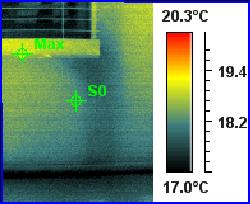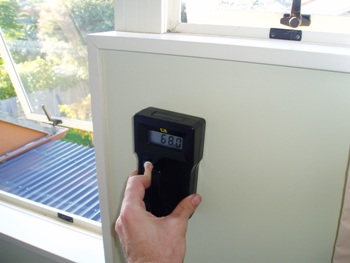Are you looking for a moisture testing company to test the timber framework in your house… or the house you’re about to buy?
It’s true… there are several companies to choose from in NZ who do moisture testing, but like any other type of business, are they using the equipment correctly? What exactly are they looking for?
Here’s what prompted me to write this post. I found an online sample of a building moisture testing report from an inspection company in the North Island. It showed the actual moisture meter he used to ‘test for moisture’ in wall. The meter had two 15mm pins and he simply put them through the gib board and onto the timber stud… here’s the problem with this method in my opinion:
First of all, gib board is 10mm thick, so the majority of the pin was directly touching the gib, and only 5mm of the pin actually penetrated the timber. So how on this earth will he detect the moisture on the outer side of the timber?
There are 1000’s and 1000’s of homes in NZ with no cavity system, which means the cladding is fixed directly onto the timber framework. If the cladding leaks through cracks (especially plaster), then it goes directly onto the outer side of the timber (cladding side). So if you stick two small pins into the internal side of the timber, and the moisture hasn’t got across that far, then the moisture inspection company could be missing the first signs of a leaky home.
Moisture testing companies in NZ will vary, so if they are going to do an invasive inspection for you, make sure they at least first drill holes through the gib that are wider than the pins, so the pins don’t take a false reading off the gib! In some cases the gib is slightly moist, but the timber is fine… yet that could throw out the reading and cause a ‘false positive’ reading.
One of the moisture testing companies we use in Auckland actually bypass the internal side of the timber and only penetrate the longer moisture meter pins into the external side of the timber as close to the cladding as possible. This is critical in most areas of the home. Leaks under windows are more likely to cause an even spread of moisture on the timber frame and the testing equipment will normally detect that from the internal side… even with a non-invasive moisture meter and usually infrared thermal imaging also.
In many cases, the moisture testing inspector will use a non-invasive meter to first establish where there are signs of moisture… and these meters will usually pick up where the moisture issues are in the home very quickly because they are extremely sensitive and calibrated accordingly… even through gib board. If timber is moist, it will transfer that moisture onto the gib and that’s what we are actually reading with the non-invasive meter, and that’s what you also are ‘seeing’ in the infrared camera photos on this website (different temperature on the surface of the gib where the leak(s) are).
Would you buy a car without even looking at it? Probably not. Well why would you buy a house without getting an idea of what the timber frame is like! After all, it’s the ‘bones’ of your walls.
Don’t get caught buying a dog like many immigrants do! The problem is they don’t even consider the moisture testing option when buying a home, mainly because most homes around the world don’t have the leaky home issues like we do here in NZ. It’s not that these offshore buyers are silly, it’s just that they aren’t aware of the problem NZ faces. Better to be safe then sorry!!








